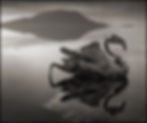The Lake That Turns Living Things Into Stone – Tanzania’s Lake Natron
- DHRUVI GOHIL
- Aug 31
- 2 min read
At first glance, Lake Natron in northern Tanzania looks peaceful — a shimmering red and pink expanse under the African sun. But step too close, and this lake reveals its deadly secret. Its waters don’t just kill — they preserve. Birds, bats, and other creatures unlucky enough to touch its caustic surface are sometimes found eerily mummified, as though turned to stone. Lake Natron’s red color comes from pigment-producing microorganisms like
Dunaliella salina algae and Halobacteria.
What makes Lake Natron so deadly?
Lake Natron sits at the base of an active volcano, Ol Doinyo Lengai, whose eruptions release sodium carbonate and other alkaline minerals into the water. The result? A lake with a pH as high as 10.5 — comparable to household ammonia. Combined with blistering surface temperatures that can reach 60°C (140°F), it’s no surprise few forms of life dare to enter.
When animals accidentally plunge in, the extreme alkalinity can burn their skin and eyes. As the carcasses dry on the scorching shoreline, the minerals effectively "pickle" them, preserving every feather and feature. Photographer Nick Brandt captured haunting images of these calcified creatures — birds frozen mid-flight, bats locked in eternal rest.
But it’s not lifeless
Despite its deadly reputation, Lake Natron isn’t empty. In fact, it’s a paradise for lesser flamingos, which thrive in these hostile waters. The flamingos feed on cyanobacteria that bloom in the lake, and the salty environment helps keep predators at bay. Incredibly, this single lake is the largest breeding ground for lesser flamingos in the world. Life finds a way — even in places that seem utterly uninhabitable. Flamingos survive Lake Natron’s caustic waters because their tough skin, salt-tolerant legs, and special diet protect them where other animals perish. They nest on salt islands and avoid the lake’s most lethal zones.
A lake of legend and caution
To locals, Lake Natron is both sacred and dangerous. Its surface often glows blood-red due to salt-loving microorganisms, fueling eerie myths of a lake that "curses" anything that enters. Scientists, however, see it as a natural wonder — a glimpse into how life might adapt on other planets or ancient Earth, when alkaline lakes were more common.
Why Lake Natron matters
Beyond its mystery, Lake Natron is a fragile ecosystem. The flamingos that on it face threats from human activity, like proposed dam projects that could alter water flow. Protecting this lake means protecting one of Africa’s most iconic species and preserving a rare geological marvel.
Photo credit-www.pandotrip.com
The stone mirror of life and death
Lake Natron feels like something out of mythology — a mirror reflecting both the resilience and fragility of life. For most creatures, it’s a deadly trap. For flamingos, it’s a sanctuary. For scientists, it’s a living laboratory. And for those who dare to stand on its shimmering shores, it’s a reminder that nature still holds secrets stranger than fiction.
Until next time, stay happy and healthy!






